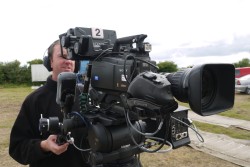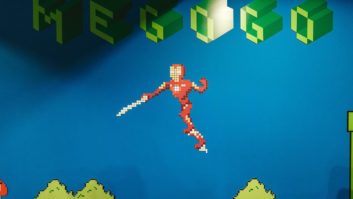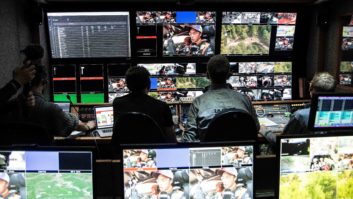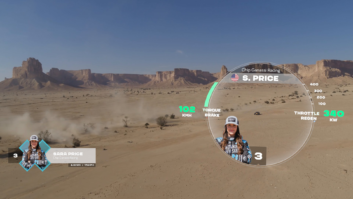
Virtual graphics provide added dimension for generating viewer information. Philip Stevens explores how one Irish broadcaster accomplished the task.
After operating under the aegis of state broadcaster RTÉ (Raidió Teilifís Éireann) for over a decade, TG4 was established as an independent state body in 2007 to provide the national Irish language television service. Alongside its programmes in Irish, the broadcaster delivers a schedule of programmes in English and other languages.
This output is distributed throughout the island of Ireland with national universal free-to-air coverage on the terrestrial platform. In addition, there is national availability to Sky satellite subscribers, plus a ‘must carry’ status on all cable platforms. Finally, there is worldwide delivery via broadband webcast through TG4 BEO/TG4 Player.
Among the programmes originating from TG4 are the traditional Irish sports of hurling and Gaelic football, as well as the Magners League rugby fixtures. “As part of our ongoing efforts to add production values for these sports we were keen to use virtual reality graphics to enhance the audience experience,” explains Maidhcí Ó Súileabháin, executive producer at Nemeton TV, TG4’s production company. “And to help us with that project we turned to one of our outside broadcaster contractors, Television Mobiles Ltd, for help.”
The brief to Television Mobiles was to provide a system with a simple user interface that would require minimum training, and be presenter and analyst friendly. And because of the various sports covered by TG4, the package needed to be readily customised to meet specific needs, while offering the capability of being easily updated when new features were required.
Ó Súileabháin continues: “This was our first venture into virtual graphics for sports. We needed a solution that packed a big punch in terms of features and which provided on pitch virtual graphics that would be analyst driven. For example, the graphics needed to show distances to goal, player tracking, incident magnification, various arrows, lines, markers and the ability to highlight players. Furthermore, we sought the ability to virtually paint on the pitch elements such as team crests, logos and so on.”
The OB company
Television Mobiles Ltd (TVM) is one of Ireland’s leading OB companies, operating seven trucks, three of which are equipped for high definition. Kevin Galvin, its operations manager, takes up the story. “In conjunction with TG4’s production company, we set about finding a solution. We had been using RT Software for a number of years for TG4 analysis sequences, so they were the obvious choice when it came to the Virtual Graphics package. Fortunately, they already had a system that would meet our needs, so the upgrade was simple.
“Beyond that, we needed an intelligent head that could collect information from the lens and send that data back to the OB Truck and into the software system. TVM has been exclusively using Vinten equipment since 1979, so this made the Intelligent Head manufacturer an easy decision.”
TVM required a head that was capable of carrying a Canon 40:1 HD lens and large viewfinder. Interestingly, at about the time TVM was talking to TG4 about virtual reality, camera support supplier Vinten revealed its new Vector 430 pan and tilt head. What makes this head special is the fact that the counterbalance suits any camera payload, so allowing complete control of the framing. It also has intelligence in the head, which allows semi-auto set-up and slide plate tracking.
Most significant for TVM, however, was the news that the head is also available in an encoded version, the Vector 430i. This version has internal detectors, which determine the precise angle of pan and tilt, accurate to 0.000225 degrees. Once aligned, the head tracks the camera movement continually.
Keeping track
The Vector 430i is complemented by the company’s Virtual Reality Interface (VRI) box. Working together these supply the pan, tilt, zoom and focus tracking data in a known packet to the RT Software rendering system.
“As well as processing the positional data from the head encoders, the VRI box also offers a direct interface to lenses with encoder outputs (or bolt on lens encoders) to provide a single data stream to the software,” states Karen Walker, Robotics commercial manager at Vinten Radamec. “Normally, just one camera is fitted with this encoding equipment – making it possible to align accurately the Virtual Reality and Augmented Reality graphics.”
As Galvin mentioned, TVM was already using RT Software’s system for TG4’s Game Analysis, so an upgrade from that company was the obvious solution.
“We already supported Vinten’s previous pan and tilt heads,” reveals Mike Fredriksen, commercial director at RT Software. “Vinten Radamec loaned us the new Vector 430i to allow us to integrate it into our software – essentially ensuring we can read the pan, tilt, zoom and focus data from the head.”
RT Software then supplied TVM with a Supermicro PC loaded with its tOG Sport Pro software. This is the company’s standard sports package customised slightly to display information in Gaelic. This customisation capability is part of the standard package. The hardware required to operate this system is a standard PC keyboard and mouse with optional touch-screen.
On location, the system is aligned by using specific targets and recording positions around the stadium and/or pitch in both the virtual and real worlds. Data from the head is then sent back to the OB Truck on a single XLR – an arrangement, which makes for easy rigging.
“Our software working with the Vinten Radamec head means when the camera moves the graphics stay in the right place and with the right perspective,” says Fredriksen. “The effect is as though the graphics are painted there in reality. But there is more than that. We are able to create an analysis sequence that is played out later — perhaps at half-time or full-time. The software typically enhances a replay with a highlight circle or magnifier, as demanded by the Analyst.” As part of the purchase of the RT Software package, the company installed the equipment, calibrated the camera lenses and provided on-the job operational training and usage guidance to TVM.
Going forward
The first OB to use the new system involved a Magners League game between Connacht Rugby and Newport Gwent Dragons. TVM used eight cameras for this production, with the Virtual Graphics System on camera one in the main stand. “From a camera operator’s point of view, we have had great feedback both on the Vinten head operations and also the ease of setting up the system,” declares Galvin.
“The combination of the Vinten Radamec head and the software package has provided the production team with further tools that do enhance the viewing experience,” reports Ó Súileabháin. “Our plan is to develop virtual graphics across our range of sports output from hurling to horse racing and to keep pace with modern and changing technologies.”
So, what of the future developments? Vinten Radamec’s Walker reveals a current project. “This is a new levelling device called an inclinometer. It is an instrumented base/ring combination which sits underneath the head to measure the pan plane and reports it to the VRI.”
She reports that this helps accommodate changes where the camera orientation differs between set-up and transmission – for example, stadia filling with spectators will sag, or someone may join the operator on a flexible platform. If those changes are not measured, it could put the virtual element out of place.
TVM’s Galvin believes more graphic developments will be coming on stream, especially with current advances in 3D productions. “3D transmissions will greatly enhance the potential of virtual graphics, so I believe that this area will require a lot of investment in the coming year.”







